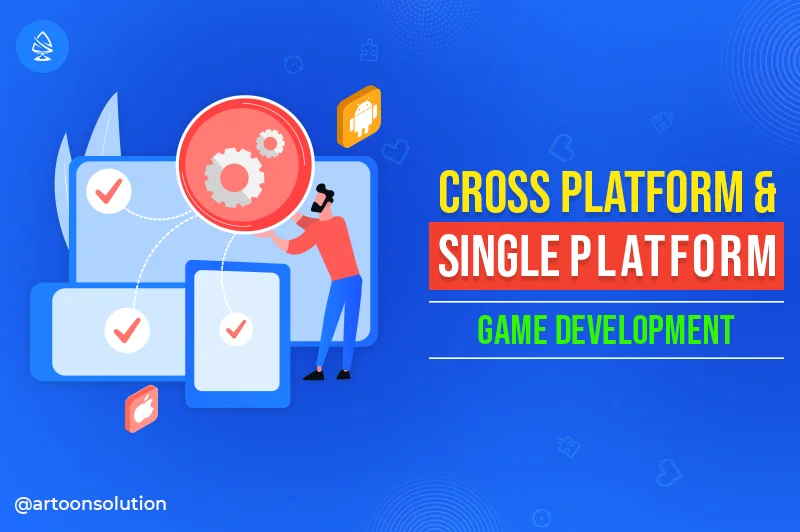- HR:+91-879-9184-787
- Sales:+91-832-0329-068

In today’s era, we are buzzing with technology and software. With every new software update, the optimization and stability of game applications have increased. We see a number of game apps acquired by users just because they provide stability i.e. no lagging issues or a hassle-free environment. There are different game development platforms in which games are developed. Cross Platform & Single Platform Game Development.
So what are the different platforms and what differentiates them?
Let’s explore in detail.
There are two game development platforms. One is Cross-platform and the other is a Single Platform Game Development.
Cross-platform means the software that can be implemented on multiple computing platforms. Here games can be quickly and easily ported onto Android, iOS, or any other OS. One of the best examples of cross-platform game development is UNITY.
A single platform means the software is platform-specific. Here a game is developed for a specific OS. One of the best examples of a single platform game development is NATIVE.
Both platforms gained popularity over the years and now they are trending topics in the gaming world.
What differentiates cross-platform and a single platform game development then?
Let’s go step by step:
In UNITY (cross-platform), there is a collection of so many packages, that is futuristic 3D models, textures, music, plug-ins, extensions, etc. There are 2D & 3D graphics available in the Unity game engine. It makes the game building simple, easy, and lag-free. Cross-platform game development is feature-rich and a smooth user experience is maintained throughout.
In NATIVE (single platform), there are not many collections of packages but they are often ranked higher because of small maintenance and better user experience.
Unity has its own IDE (Integrated Development Environment). An IDE is a software application that provides facilities to programmers for software & game development. An IDE consists of a source code editor, build automation tools, and a debugger. Unity has a very easy interface. When you write code in unity you create logic around an object that can simply be set by adding recovered via code and will be available for logical conditioning. Cross-platform offers so many features within the code editor like for example it has a drag and drop environment.
Unity uses DOTS (Data-Oriented Technology Stack) that makes great games run faster on multiple processors without the headache of heavy programming. DOTS enables programmers’ coding skills as it allows them to write safe multithreaded code for massive performance gain. With the use of DOTS conversion workflow converts game objects to entities with just one click.
The game that supports platform-specific language to run on the target platform is known as Native Platform. It means the Native is a single platform game development engine. If we look at the performance, Native game development is unmatched. For a particular device platform, it fits into the game interface very easily. This ensures hassle-free app performance and as per the compatibility, it suits the platform perfectly. Most importantly developers can offer gamers familiar UI elements which ensure better user engagement.
When it comes to trending features 3D graphics and avatars have the better edge. These are the new modern ways of attracting a large number of gamers in a small time. 3D avatars make the game very interesting and almost every player looks for an avatar-based game. In 3D avatar-based games everything is 3D and it comes with animation effects that create a new aura for the gamers. Both Cross-platform and single platform have their own set of personalized assets to develop 3D graphics and 3D avatar-based games.
UI is the face of the game for professional gamers. It represents your game app development skills and techniques. The developers need to personalize it well so that it stands out from other games. In cross-platform, the UI is more advanced and feature-rich whereas, in a single platform, the UX is better due to the single OS and smooth performance.
Some examples of games developed in Unity: Rummy, Poker, Ludo, Teen Patti, etc.
Some examples of games developed in Native: Super Bowl, Zombie Aircraft, Football Kick, etc.
Read More: Why do you Need to Build Cross-Platform Games in 2023?
Deciding on a game development platform is a tough decision, isn’t it? Especially when you know the features of both platforms. If the goal is to capture a large user base regardless of any OS platform Unity is the best choice. However, if you want to acquire a user base on a single OS (i.e Android, iOS) then Native is the one to go with.
Are you looking for a game development company that has all the resources covered?
Artoon Solutions Pvt.Ltd. is having more than 14+ years of developing mobile or web games with perfection in delivery. We have 250+ in-house proven and experienced dedicated teams of 2D/3D Designers, Frontend/Backend Developers, QA Team (Testers), Server management team, Project managers that can cater to every challenge.
Let’s get in touch and we assure you to turn your dreams into reality.
Copyright 2009-2024
